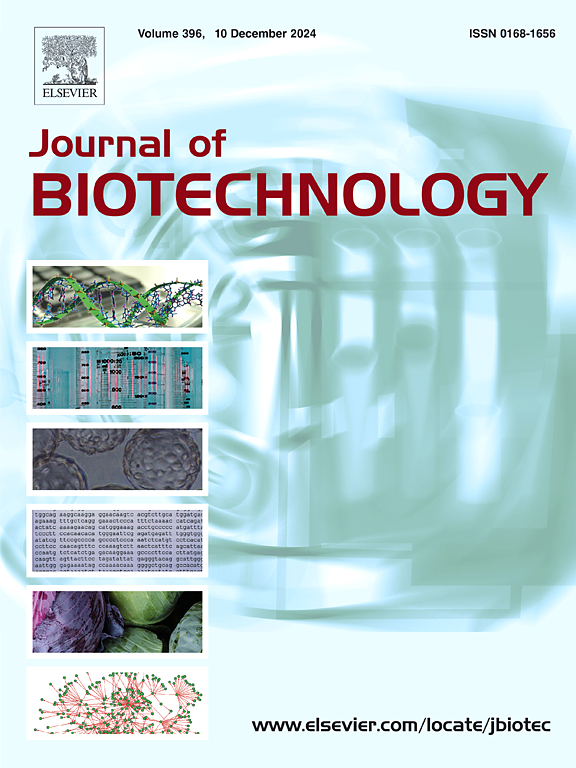基于嗜麦芽寡养单胞菌的自转运体构建大肠杆菌表面展示平台:低分子量到高分子量酶的自动展示。
IF 4.1
2区 生物学
Q2 BIOTECHNOLOGY & APPLIED MICROBIOLOGY
引用次数: 0
摘要
表面显示技术在制备高效的全细胞催化剂方面得到了广泛的关注,而目前已有的载体蛋白仍不能满足显示各种乘客结构域的需求,特别是那些具有高分子量的乘客结构域。本研究表明,嗜麦芽窄养单胞菌酯酶Est7 (E7AT)的自转运体在其高效的表面展示中起着决定性作用。在原始信号肽的引导下,测定了Est7的表面显示率为89.67%,总酶活性为16.67U/mL,远高于pectolase B (pelB)和霍乱毒素B (ctxB)衍生的信号肽的4.60U/mL和5.70U/mL。然后,E7AT单元被成功开发用于表面显示从19.3kDa到117.9kDa的不同分子量的蛋白质,显示出比参与弥散粘附(AIDA-I),冰核蛋白(InaK和InaP)和外膜蛋白(脂蛋白/ompA, mlta相互作用蛋白a和yiaT)系统的粘附素更有效的自动显示能力。此外,利用E7AT显示的半乳糖苷酶(GAL)水解乳糖,在2小时内实现了31.63%的水解率。所示的GAL在第三批和第六批分别保持了63.24%和41.41%的活性,表明E7AT在开发高效全细胞催化剂方面具有相当大的潜力。本文章由计算机程序翻译,如有差异,请以英文原文为准。
Engineering an Escherichia coli surface display platform based on an autotransporter from Stenotrophomonas maltophilia: Autodisplay of enzymes with low to high molecular weight
Surface display technology has garnered significant attention for preparing efficient whole cell catalysts, while reported carrier proteins still cannot meet the demand to display various passenger domains, especially for those with high molecular weight. This study demonstrates that the autotransporter of esterase Est7 (E7AT) from Stenotrophomonas maltophilia played a decisive role in its efficient surface display. Guided by the original signal peptide, the surface display ratio of Est7 was determined as 89.67 % with the total enzymatic activity of 16.67 U/mL, which was much higher than 4.60 U/mL and 5.70 U/mL for the signal peptides derived from pectolase B (pelB) and cholera toxin B (ctxB), respectively. Then, the E7AT unit was successfully developed to surface display proteins with varying molecular weight from 19.3 kDa to 117.9 kDa, showing a more effective autodisplay ability than adhesin involved in diffuse adherence (AIDA-I), ice nucleation proteins (InaK and InaP), and outer membrane proteins (lipoprotein/ompA, MltA-interacting protein A, and yiaT) systems. Additionally, a galactosidase (GAL) displayed by E7AT was employed to hydrolyze lactose, achieving a promising hydrolysis rate of 31.63 % in 2 h. The displayed GAL retained 63.24 % and 41.41 % activity in third and sixth batch, respectively, indicating the considerable potential of E7AT in developing efficient whole cell catalysts.
求助全文
通过发布文献求助,成功后即可免费获取论文全文。
去求助
来源期刊

Journal of biotechnology
工程技术-生物工程与应用微生物
CiteScore
8.90
自引率
2.40%
发文量
190
审稿时长
45 days
期刊介绍:
The Journal of Biotechnology has an open access mirror journal, the Journal of Biotechnology: X, sharing the same aims and scope, editorial team, submission system and rigorous peer review.
The Journal provides a medium for the rapid publication of both full-length articles and short communications on novel and innovative aspects of biotechnology. The Journal will accept papers ranging from genetic or molecular biological positions to those covering biochemical, chemical or bioprocess engineering aspects as well as computer application of new software concepts, provided that in each case the material is directly relevant to biotechnological systems. Papers presenting information of a multidisciplinary nature that would not be suitable for publication in a journal devoted to a single discipline, are particularly welcome.
 求助内容:
求助内容: 应助结果提醒方式:
应助结果提醒方式:


